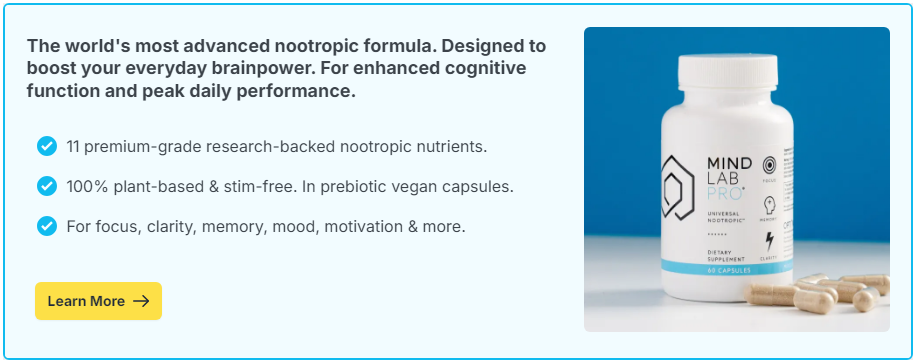
Great ideas rarely arrive on cue, yet teams still need fresh concepts by Friday. Enter the idea sprint, a short burst of structured creativity that trades chaos for clear steps. Here you see how to generate many good options, keep energy steady, and choose winners without stomping the spark. You also get a quick primer on ingredients many creators keep in their kit for calm focus, steady stamina, and better recall.
Contents
- Idea Sprints 101, What Creative Divergence Actually Requires
- Priming the Brain, Fuel, Light, and Movement That Help Ideas Show Up
- Stimulant Timing for Makers, Clear Energy Without the Crash
- Nootropic Primer, Ingredients That Support Divergence and Recall
- Sprint Mechanics, Prompts and Constraints That Unlock Divergence
- Convergence Without Killing Magic, Picking Winners with Care
- Recovery and Integration, Make the Sprint Pay You Back
Idea Sprints 101, What Creative Divergence Actually Requires
Brainstorms often collapse into loud voices and vague stickies. An idea sprint is different. It uses tight constraints, visible time boxes, and alternating phases of divergence and convergence. The goal in divergence is quantity with variety. You want many distinct directions, not twenty shades of the same thing. To pull that off, you need a clean brief, specific prompts, and a room tuned for attention rather than chatter.
Start with a one page brief that names the user, the context, the real constraint, and the desired effect. For example, help first time buyers compare plans in sixty seconds on mobile, within the legal limits we must follow. That sentence trims thousands of irrelevant paths. Next, set the cadence. Most teams do three 20 minute divergence blocks with short movement breaks between them, then one 30 minute convergence pass.
Track useful numbers. Quantity matters, so count ideas per person and per round. Variety matters more, so label each idea with a micro genre tag, such as constraint workaround, playful reveal, instant compare, or risk reducer. You will see quickly whether your concepts cluster too tightly. To keep momentum high, remove social friction. Use silent start rounds where people sketch or list ideas alone, then share. Introverts bring thoughtful directions when the room is quiet first, extroverts still get to shine during share outs. Clear structure turns that mix into fuel rather than friction.
Priming the Brain, Fuel, Light, and Movement That Help Ideas Show Up
Creative thinking is a metabolic sport. You will get better ideas if the body feels supported and the environment feels spacious. Begin with fuel that keeps energy even, not sleepy. A simple plate works well, protein plus slow carbs plus color. Eggs with avocado and a small tortilla, Greek yogurt with berries and oats, tofu with rice and vegetables. Bring a snack kit so the cookie tray does not become the strategy. Good options include nuts, fruit, edamame, and string cheese. Hydrate early, then keep a bottle within reach.
Light is a lever. Bright, even light cues alertness during divergence blocks. Warmer, dimmer light suits reflection during convergence. If you can, set a task lamp above eye level for sketching, then soften to a warmer setting when you begin voting and ranking. Temperature should favor slightly cool. Movement matters too. Short breaks with stair climbs or hallway walks reset attention and often unlock ideas that were one step away. Keep phones off the work surface so your visual field stays clean.
Add two simple rituals. First, a two minute pre block routine, top up water, clear the table, breathe slowly twice, choose one prompt. Second, a 30 second close, title the page, circle your three favorites, and mark one to develop next. These micro habits reduce decision friction and make ideas easier to revisit later. If your team uses music, pick lyric free tracks at low volume during divergence so language systems are not competing with your thoughts.
Stimulant Timing for Makers, Clear Energy Without the Crash
Caffeine can help, but a mountain of it does not equal better ideas. Aim for calm alertness. Many creators pair caffeine with L Theanine, an amino acid in tea that often takes the sharp edge off stimulants. Start with a modest dose before the first block, then switch to water or green tea. Set a hard cutoff several hours before you plan to sleep, because brilliant ideas are not useful if you are wrecked tomorrow. If energy dips mid sprint, try light and movement first, then a small top up if needed.
Some people add targeted supports on busy days. L Tyrosine is a building block for dopamine and norepinephrine and is often used earlier when pressure is high and decisions stack. Rhodiola Rosea is chosen by some for stamina during repetitive work, better early than late. Citicoline is commonly used for clear attention during complex edits or when juggling many threads. Phosphatidylserine can sit near the end when you want focus for documentation without more buzz. Maritime Pine Bark Extract is valued for a fresh, clear feel, and many place it in the morning with the first water bottle. Always consider your own response and any guidance from your clinician.
The simplest rule set wins under load. Two short caffeine windows only, light on, phone face down, three minute walk each break, water at the halfway mark of every block. Decision fatigue is the enemy of creative momentum, so write your rules once and follow them rather than renegotiating every hour.
Nootropic Primer, Ingredients That Support Divergence and Recall
Nootropics are not paintbrushes that make art by themselves. They are backstage tools that help you hold attention, stay even under stress, and remember what you generated. The ingredients below are widely used and often appear together in comprehensive formulas. Use them thoughtfully, start low, and keep notes for two weeks so you can tune timing rather than chasing a perfect stack on day one.
Calm Focus and Signal Clarity
- L Theanine: often paired with caffeine for smooth attention. Many people find it helpful during early blocks, especially writing and sketching that require steady hands and a quiet mind.
- Citicoline: commonly chosen for mental energy and focus on complex problem framing. Useful when switching between several prompts or comparing pathways.
Stress, Stamina, and Flow Windows
- L Tyrosine: a precursor for dopamine and norepinephrine. Some creators use it earlier in the day when pressure is high so decision making stays sharp.
- Rhodiola Rosea: included by many for fatigue resistance during long workshops and repetitive evaluation passes. Place it early to mid day so it does not crowd sleep.
Memory and Long Game Clarity
- Bacopa Monnieri: a daily ingredient used over weeks for learning and recall. It supports the background skill of retrieving prior art and analogies during sprints.
- Lion’s Mane Mushroom: widely used for general cognitive support. Many describe a clean clarity that suits creative phrasing and synthesis work.
Structural and Circulation Support
- Phosphatidylserine, PS: chosen by some for attention and composure. It often fits late in the day when you are documenting outcomes and need calm focus.
- Maritime Pine Bark Extract: valued for circulation and antioxidant support. Many place it in the morning before long sessions at the whiteboard.
Pick roles, not a pile. One calm focus option plus one stamina option is usually enough for sprint days. Keep longer horizon supports in your daily routine so benefits accumulate between projects.
Sprint Mechanics, Prompts and Constraints That Unlock Divergence
Great prompts multiply options. Use specific, playful constraints that push thinking in new directions without wandering off the brief. Here are formats that work well in 20 minute bursts:
- SCAMPER: Substitute, Combine, Adapt, Modify, Put to another use, Eliminate, Reverse. Pick three letters per round and force five ideas under each letter.
- Opposites: If your norm is more features, ask what if the product did only one thing perfectly. If the norm is onboarding in minutes, ask what if onboarding took a day and was worth it.
- Analogy mine: Borrow moves from a different domain. How would a museum guide present this data, how would a food truck schedule handle our load.
- Random fuse: Pull a random word card and connect it to the brief in three steps. Weird bridges produce fresh concepts.
- 6–3–5 brainwriting: Six people write three ideas in five minutes, pass the page, then build on what they receive. After three rounds you have a thick stack without anyone dominating.
- Sketch first: One minute thumbnails before any words. Pictures disrupt default phrasing and invite different pathways.
During share outs, ban premature evaluation. Ask presenters to title each idea in five words or fewer, then move on. Save questions for the convergence phase. To keep things brisk, use a bell or a timer, and rotate facilitators so everyone stays engaged. Post the pages on a wall or a digital board and label each with its genre tag. You will see variety at a glance, which is exactly what you want before you start narrowing.
Convergence Without Killing Magic, Picking Winners with Care
Selection should reduce noise, not flatten originality. Start by setting kill criteria that everyone agrees on, legal nonstarter, violates a hard constraint, or harms a core user. Remove those quickly. For the rest, score on three axes with simple one to five dots, user impact, feasibility in the next quarter, and differentiation. Keep the math light. The goal is to highlight promising clusters, not to pretend that creativity is a spreadsheet.
Use two passes. First, dot vote silently, one color for impact, one for feasibility. Second, discuss only the top quarter of ideas. Ask for the smallest believable version, the kitchen counter prototype you could build next week. Many strong ideas die because teams picture the final cathedral instead of the first brick. If debates stall, use a decider who is named in the brief to choose a direction and a fast follow test. Document assumptions, what must be true for this to work, and design small tests that can falsify them quickly.
Finish with commitments. Who will prototype, what will be measured, and when will you reconvene. Capture a one page sprint summary, the brief, the top five ideas with a line sketch each, the chosen path, the first test, and owners. Share it within 24 hours so energy does not leak away. Convergence can be kind to creativity when it respects the work that got you here.
Recovery and Integration, Make the Sprint Pay You Back
After a strong sprint, your brain needs to consolidate. Give it rest so ideas can move from short term buffers into longer term networks. Keep screens dim that evening, stop caffeine early, and sleep in a cool, dark room. A short walk the next morning plus sunlight on your eyes will help you feel fresh for the prototyping push. If you use longer horizon supports like Bacopa Monnieri or Lion’s Mane Mushroom, daytime is a common window so benefits build between sprints.
Schedule two revisits. First, a 24 hour check to sanity test assumptions with a clearer head. Second, a two week check to assess early test data and decide whether to expand, pivot, or shelve. Keep a living scrapbook of killed ideas that were interesting. Many breakthroughs are yesterday’s stretch ideas seen in a new light. Protecting that archive pays unexpected dividends.
Finally, teach the system to repeat. Store templates, timer links, and prompt cards where anyone can run a session. New teammates should be able to pick up the kit and get moving without a lengthy orientation. Creativity thrives when the process is visible and learnable. Give the team a structure they can trust, and their best thinking will show up more often.

